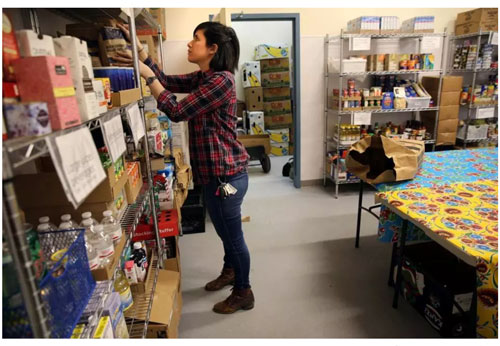Employee theft ‘shockingly common’ at nonprofits
Boston Globe
By Todd Wallack
27 January 2018

“The whole
thing has been a nightmare,” said Mark Alston-Follansbee, executive
director of the Somerville Homeless Coalition, whose former chief
operating officer is accused of embezzlement. Craig F. Walker Globe Staff
A board member for the Somerville Homeless Coalition was reviewing the
nonprofit’s annual financial documents in 2015 when he spotted
something odd. The forms said the chief operating officer, the No. 2
executive, earned $12,000 more than the organization’s top executive
the previous year. Could that really be correct, he asked?
Turns out it wasn’t a typo. It was theft.
Somerville Homeless soon discovered that the COO — who handled all the
finances — allegedly embezzled approximately $108,000 over 18 months.
The charity said he brazenly added some of the money directly into his
paycheck — where it showed up on the group’s annual financial forms —
used the organization’s credit card for personal expenses, and added
his middle-aged son to the group’s health insurance.
“The whole thing has been a nightmare,” said Mark Alston-Follansbee,
executive director of the Somerville nonprofit, which provides food,
shelter, and other assistance to about 2,000 people annually. “The
money he stole from us could have prevented 100 families from going
homeless.”
More than 1,100 tax-exempt organizations nationwide have reported
theft, embezzlement, or other major diversions of assets over the past
seven years, according to electronic filings with the Internal Revenue
Service. And experts say the total number of thefts is almost certainly
far higher, because most cases of fraud are either never detected or
reported in the digital filings.
“It’s shockingly common,” said Gerry Zack, a certified fraud examiner
who recently was named incoming chief executive of the Society of
Corporate Compliance and Ethics, a Minneapolis-based organization.
nonprofits are particularly vulnerable for a variety
of reasons: Many nonprofits are small organizations, led by people who
are passionate about their causes but may not have a background in
finance. Board members are typically volunteers, with limited time or
expertise in oversight.
To be sure, for-profit businesses are regularly victims of fraud as
well. But some say nonprofits are particularly vulnerable for a variety
of reasons: Many nonprofits are small organizations, led by people who
are passionate about their causes but may not have a background in
finance. Board members are typically volunteers, with limited time or
expertise in oversight.
Thefts, in fact, can be hard to spot. For instance, when a contribution
goes missing, the fraud may go undetected because donors generally
don’t expect anything in return for their gifts, unlike business
customers who usually complain when what they paid for never comes.
“There’s at least anecdotal evidence that would suggest nonprofits are
more susceptible to fraud than traditional for-profit companies, said
Zack, who also teaches classes for the Association of Certified Fraud
Examiners, based in Austin, Texas.
The issue is particularly relevant in Greater Boston, where so many
prominent institutions are nonprofits, including major hospitals,
universities, museums, and research organizations. More than 70
nonprofits in New England have told the IRS they were victims of
embezzlement or theft in recent years.
For instance, a bookkeeper was sentenced to two years in prison in 2016
for stealing $800,000 from the National Veterans Services Fund of
Darien, Conn., from 2009 to 2014, writing checks to herself and then
altering the ledgers to make it appear the money went to veterans.
Population and Development International, a nonprofit dedicated to
helping the rural poor in Southeast Asia, reported its then-president
diverted $950,000 for his personal use in 2012 when the group was based
in Boston. The charity said the executive promised to make full
restitution as part of a settlement, but a former director said no one
was ever prosecuted.
And a former machine shop manager at Massachusetts General Hospital in
Boston was sentenced to a year in prison in 2014 for stealing more than
$640,000, in part by ordering tools and equipment for his own use as
well as by selling leftover brass discs to scrap dealers after they
were used in radiation treatments.
The problem is national in scope, touching some of the country’s
best-known nonprofits. The American Museum of Natural History in New
York City reported it lost $2.8 million in 2015 after an employee fell
for an e-mail scam and erroneously wired the money. The museum reported
the incident to police, but the perpetrators have yet to be identified
or return the money.
The IRS asks tax-exempt organizations to disclose any significant,
unauthorized diversions of assets (usually meaning theft or
embezzlement) on a key annual filing with the agency, called a 990. The
Globe found more than 1,100 organizations across the country have
checked the box on forms filed electronically since 2011.
But the vast majority of nonprofits never even face the question. The
IRS omitted the diversion question from versions of the form filed by
foundations and most smaller organizations, while certain types of
organizations, such as churches, are not required to file at all. And
many organizations fill out paper forms, where the data are harder to
compile. Overall, fewer than 1 in 7 nonprofits file the standard 990
electronically each year.
And even organizations that file electronic 990s aren’t required to report smaller thefts.
For instance, a temporary employee was caught in 2013 embezzling
$68,000 from the Boston VA Research Institute, which supports medical
research and education in the VA Boston health care system. The
employee was sentenced to prison, but the nonprofit never reported the
incident to the IRS, citing agency guidelines that say nonprofits need
only report diversions totaling more than $250,000 (unless it amounts
to more than 5 percent of the organization’s gross receipts or assets).
Many organizations fear news about employee theft could damage their reputations and make it harder to raise money from donors.
“Donors don’t want to be associated with anyone in the nonprofit world
who has a bad news cloud over their head,” said Tom McLaughlin, a
nonprofit consultant in Andover who has published several books on
financial management in the sector.
So nonprofits typically avoid publicity when they discover someone
pilfered funds. In some cases, nonprofits try to quietly negotiate
deals to have workers leave or repay the organizations instead of
reporting theft to police.
“I have had cases where they don’t want to prosecute,” said Janet
Fohrman, a certified fraud examiner and chief executive of Fohrman
& Fohrman, a nonprofit accounting firm in Laguna Hills, Calif.
“They just want to sweep it under the rug.”
And even when organizations go to police, it doesn’t always result in
criminal charges, because embezzlement cases can be difficult to
prosecute — especially when they involve organizations with messy
financial records or cash contributions that don’t leave a financial
trail.

Pantry
associate Marni Berliner worked at the Somerville Homeless Coalition’s
food pantry. Craig F. Walker Globe Staff
The Somerville Homeless Coalition said it quickly fired executive
Warren McManus after discovering the theft in November 2015. It also
sent a letter to donors in March 2016 and reported the incident to the
US Department of Housing and Urban Development, which supplies about
one-third of its funding.
“We recently discovered that one of our employees engaged in financial
misconduct that has led us to terminate his employment,” the group told
donors. “We at SHC were shocked and disappointed, to say the least, by
our former colleague’s breach of trust.”
A 2017 HUD report confirmed that independent auditors found funds were
misappropriated. HUD said it referred the matter to its Office of
Inspector General, which is charged with investigating fraud and
misconduct.
But no one has ever been prosecuted or publicly accused of the theft.
The group’s initial letter to donors did not include McManus’s name,
and it asked recipients to treat details confidentially. And it hasn’t
been previously mentioned in the media.
Indeed, the news was kept so quiet that the city of Cambridge passed a
glowing resolution praising McManus, five months after his firing, for
his years of service to young and disadvantaged people. Cambridge
officials said they weren’t aware of the embezzlement allegations at
the time.
Alston-Follansbee said he did not report the theft to Somerville Police
because an agent with HUD’s Office of Inspector General told him he was
handling the investigation and would notify other key officials. “I
would like to see this guy in jail,” Alston-Follansbee said. HUD’s
inspector general said it could not confirm or deny any investigatory
actions.
McManus, who now lives in upstate New York, initially hung up on a
reporter calling for comment. But he later called and e-mailed to
explain the situation after the Globe sent him a letter by certified
mail.
The 71-year-old said he handled the finances, purchases, and other key
duties for the organization for more than two decades. “I ran the
show,” he said.
McManus said he typically worked seven days a week and took only three
holidays a year. Instead of taking vacations, he said, he generally
paid himself extra for the time he had earned. But at some point, he
apparently lost track of his hours.
“The problem became that I took more vacation time than I earned,” McManus said.
McManus also acknowledged that he added his adult son to the agency’s
health insurance policy, even though Somerville Homeless said the son
was never eligible. “He is a bad diabetic, so I put him on for a short
time,” McManus said, adding that he later forgot to take him off the
policy. “It is entirely my fault,” he said.
McManus said he met with federal investigators last Thursday, signed a
statement concurring with several allegations, and agreed to pay back
$61,854. (It’s not clear why the figure is less than the $108,000
Somerville Homeless’s executive director estimated McManus owes.)
“I’ll own up to it,” McManus said. “I’ll make full restitution.”
Carolina Deleon comforted her daughter Jereiwi De Los Santos, 4, at the
Somerville Homeless Coalition Family Shelter, where they are guests.
But McManus said he hadn’t seen any allegations that he misused the
agency’s credit card, so he wasn’t sure whether those allegations were
correct.
And McManus said he feels the organization owes him as well. Shortly
before he was fired, he said, he submitted an invoice for more than
$50,000 for extra hours he worked. He said he got no response.
Meanwhile, Somerville Homeless said it has learned from the experience.
“We thought we had good controls and financial systems,” Alston-Follansbee said. “We found out we had neither.”
The organization has since replaced its auditors, hired additional
finance staff, spread out the financial responsibilities, and
implemented a new 150-page set of policies. It has also worked with HUD
to address any outstanding concerns.
Alston-Follansbee said many donors were understandably upset after they
learned about the embezzlement. But he said they have continued to
support the organization. The group ended last year with a small
surplus.
“People were angry, but they did not desert us,” he said. “We’re still here.”
Major nonprofit losses
More than 1,100 nonprofits told the IRS they suffered a significant,
unauthorized diversion of assets - usually theft or embezzlement - in
electronic filings processed between 2011 and 2017. The list is
incomplete for various reasons. The IRS asks the question on the
standard information return, called a 990, but not on versions filled
out by most private foundations or smaller organizations. Many
organizations still file paper forms. And the IRS requires
organizations to report thefts only of $250,000 or more, unless they
involve at least 5 percent of the group's income or assets.
top contents
appendix
previous next

